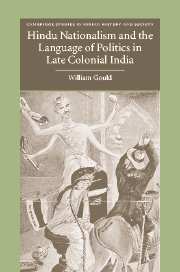Book contents
- Frontmatter
- Contents
- Acknowledgements
- Glossary
- List of abbreviations
- 1 Introduction
- 2 Congress and the Hindu nation: symbols, rhetoric and action
- 3 Muslims, mass movements and untouchable uplift
- 4 The Aryan Congress: history, youth and the ‘Hindu race’
- 5 Congress radicals and Hindu militancy
- 6 Congress ‘Raj’, riots and Muslim mass contacts
- 7 Congress, Pakistan and volunteer militarism
- 8 Conclusion
- Bibliography
- Index
- Other titles in the series
4 - The Aryan Congress: history, youth and the ‘Hindu race’
Published online by Cambridge University Press: 11 July 2009
- Frontmatter
- Contents
- Acknowledgements
- Glossary
- List of abbreviations
- 1 Introduction
- 2 Congress and the Hindu nation: symbols, rhetoric and action
- 3 Muslims, mass movements and untouchable uplift
- 4 The Aryan Congress: history, youth and the ‘Hindu race’
- 5 Congress radicals and Hindu militancy
- 6 Congress ‘Raj’, riots and Muslim mass contacts
- 7 Congress, Pakistan and volunteer militarism
- 8 Conclusion
- Bibliography
- Index
- Other titles in the series
Summary
The campaign for untouchable uplift, prompted by Gandhi's fasts of September 1932 and May 1933, revealed a harmony of interests between UP Congressmen and the Arya Samaj. The Samaj had moved beyond the confines of social and religious reform from an early date in the twentieth century, strongly identifying itself with Congress and extremist movements in the 1900s and 1910s. It was most prominent in Punjab in this period, but there were some important figures working in UP, especially in the west of the province. These included Bishan Datt, a swadeshi propagandist of Mirzapur, Dharma Bhikshu who edited an extremist daily in Lucknow, Hari Lal Gupta of Saharanpur, and Sundar Lal of Muzzafarnagar. Other Samaj leaders with an all-India presence also figured in UP politics, most notably Munshi Ram, Lala Lajpat Rai and Bhai Parmanand. Munshi Ram (later Swami Shraddhanand) had inaugurated a system of education which imparted Vedic instruction alongside western learning at the Kangri Gurukul near Hardwar – an institution which was to form a propagandistic centre for the activities of some Congressmen in the 1930s.
Whilst a number of Congressmen were embarrassed by associations with the Samaj in UP, especially in the light of the 1920s' ‘shuddhi’ campaign, the political context of the early 1930s encouraged Samaj–Congress associations. The Gandhian approach of ‘self-denial’ had attracted Swami Shraddhanand to politics during the non-cooperation movement in 1920. This form of ascetic politics was popularised once again in 1930.
- Type
- Chapter
- Information
- Publisher: Cambridge University PressPrint publication year: 2004



